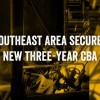In a world where people ask, ‘Who is standing with Labor?’—we are.
Bank of Labor’s vault view at the grand reopening of the Main Bank following the 1950 remodel.
View Photo Gallery (5 photos)
Bank of Labor, which is celebrating its 100th year of service, is a unique financial institution in the American banking landscape—founded on principles of solidarity, fairness and service to working people. Established in 1924 as Brotherhood State Bank, it was initially chartered by the International Brotherhood of Boilermakers to provide union members and labor organizations with reliable, trusted banking services versus the mainstream financial institutions that often excluded or exploited working-class people. Bank of Labor represented a business model of economic independence, self-determination and shared values.
“In those days, banks didn’t want to do business with American workers,” said Chairman and CEO of Bank of Labor Bill Miller. “Their needs and financial resources weren’t considered substantial enough to meet banks’ profitability threshold. Bank of Labor’s message, working hard for hardworking people, reinforces banking solutions to help workers.”
Today, Bank of Labor is headquartered in Overland Park, Kansas, and remains deeply rooted in its mission. It offers a full range of financial services to individuals, labor unions, pension funds and related institutions across the country.
“We couldn’t exist without labor,” Miller said. “And we’re here to make labor stronger.”
Unlike profit-driven banks that may invest in companies or causes that are contrary to workers' interests, Bank of Labor emphasizes transparency, ethical practices and a strong social conscience.
“We don’t invest in things that undermine labor rights,” Miller said. “We partner with businesses and organizations that demonstrate a commitment to labor and our community.”
In 2012, the bank built a platform that would expand their mission of serving the labor movement across the nation, rebranding itself from Brotherhood Bank and Trust to Bank of Labor. This transition marked a significant step in its evolution from a regional bank into an institution with a national footprint, poised to amplify labor’s voice in the financial world.
“For the last 100 years, we’ve found a way not only to remain relevant but to compete with any bank in the United States,” Miller said. “Last year we achieved a billion-dollar threshold in assets. We believe that important milestone is now in our rearview mirror.”
The bank also plays a crucial role in labor-focused financial services, offering specific programs for union treasurers, such as electronic dues collection and tools to help manage pension and benefit funds. It has earned the trust of major labor organizations such as the AFL-CIO, IAM, UFCW, LIUNA and IBEW, to name a few.
Yet perhaps what sets Bank of Labor most apart is its people-first culture and value-driven approach.
“We really work hard to bring a personal approach to everything we do,” Bank of Labor President Bob McCall said. “When someone calls, our employees take a personal interest in fulfilling the reason for the phone call. We’re not saying you can operate without tech—but you can’t provide a high level of consistent good service without interested and capable people. We tend to take things personally, but in a good way.”
International Brotherhood of Boilermakers’ International President Tim Simmons said, “Banking with the bank we formed 100 years ago to support labor is more than a financial decision, it’s a show of solidarity and financial acuity. While the first 100 years have been successful, I’m more excited about Bank of Labor’s readiness to support and strengthen labor for the next 100 years.”
Bank of Labor exists because of the Boilermakers, and it remains majority-owned by the union today.
“Labor unions are focused on helping their membership,” Miller says. “We’re here to be a financial partner by providing financial tools that keeps labor’s capital working for labor.”
After a century of service, Bank of Labor continues to prosper as a labor-owned, union-loyal institution, driven not by Wall Street profits, but by the economic well-being of the people who build America. Bank of Labor further reinforced their union support by partnering with the United Mine Workers of America to organize their employees, so they’d enjoy the benefits of union representation.
In a banking industry dominated by corporate giants, Bank of Labor remains a powerful example of what solidarity and vision can achieve.
“In a world where people ask, ‘Who is standing with labor?’—we are!” Miller said.










